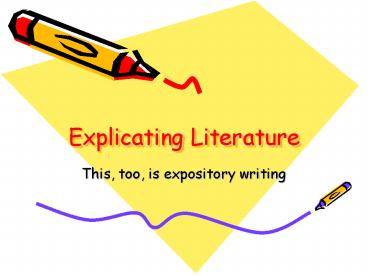Explicating Literature - PowerPoint PPT Presentation
Title:
Explicating Literature
Description:
Explicating Literature This, too, is expository writing Explication Explication evaluates literature by analyzing its elements Plot Setting Character Tone and Mood ... – PowerPoint PPT presentation
Number of Views:43
Avg rating:3.0/5.0
Title: Explicating Literature
1
Explicating Literature
- This, too, is expository writing
2
Explication
- Explication evaluates literature by analyzing its
elements - Plot
- Setting
- Character
- Tone and Mood
- Theme
- Point-of-View
- Symbolism
3
Explication
- Requires you to use information from the text to
prove your statements about the selection (very
much like you use test results to prove a
hypothesis in science) - Explication questions often ask you to
- Discuss
- Describe
- Summarize
- Compare/contrast
4
Discuss
- When asked to discuss, you may
- Explain
- Give examples
- Define
- Show how you know (where did you find the
information or ideas)
5
Describe
- When asked to describe, you may
- Define the characteristics
- Use adjectives
- Create a picture with words
- When describing characters, write about what they
say, what they do, how they relate to other
characters
6
Compare/Contrast
- Comparison illustrates how things or people are
similar. - Contrast illustrates how things or people are
different. - Pay careful attention to these words in
directions.
7
Summarize
- Summarizing is an important way to process
information. In addition to being part of
explication, you may use summarizing to - Take notes on lectures
- Take notes on reading
- Take notes on research
- Take notes on viewing
8
Plagiarism
- It is important to avoid plagiarism. Plagiarism
is a fancy word for copying someone elses work
and words. Legally, it is a crime to copy an
authors work from a book, song, video, etc. In
school, copying is considered cheating. Letting
someone copy from you is also considered
cheating. Homework and classwork should not be
copied or done together unless directed to do
so.
9
Summarizing
- Do not copy or cut and paste large sections of
text. This is plagiarism (cheating) and will
receive NO credit - Do cite select pieces of text that illustrate
main ideas, key facts, important vocabulary. Use
quotation marks around citations and identify
sources. This rule applies to pictures and
graphics, as well.
10
Summarizing
- Paraphrase and summarize the important
information in your own words. - Interpret and use the information to reach
conclusions, draw inferences, and make
predictions.
11
Be Text-Based
- Do use specific language from the text in your
response to demonstrate the way that the text
relates to your topic or question. - Remember that reading questions ask what the text
(author) says, not only what you think. If a
question asks your opinion, you still need to
support it with text that supports your point.
12
A Explication
- A explication connects your discussion of the
text to your own experience and to other related
knowledge - A explication summarizes relevant facts from the
text, interpreting and reflecting on their
significance as you write































